TL;DR: I defend the “optimist” position on the economic performance of Tsarist Russia. The pre-1914 Russian economy was experiencing sustained economic growth which was interrupted by WWI and curtailed by the Bolshevik Revolution and Civil War. The “pessimist” stance ignores or explains away real signs of capitalist development in Russia in spite of its bad institutions. Main points:
- Russia had cheap labor, abundant natural resources, and tons of foreign investment capital plus access to technology.
- Russian political and economic institutions were not developmentalist, but were improving under the pressure of social unrest and military modernization.
- Russia’s domestic market was large and prosperous enough to make protectionism work AND there was no prewar crisis of rural living standards.
- Latin America is not the correct counterfactual for non-communist Russia; other primary product exporters (notably the US) successfully transitioned.
- Russian heavy and light industry grew far more rapidly prior than agriculture prior to the First World War, leading to structural transformation.
- The trigger for Revolution was more likely the wartime collapse of the Russian economy than its inherent weakness.
Investors of the Belle Epoque would have been surprised to hear the modern consensus that Russia was a structurally weak, doomed economy. In the decades preceding the July Crisis, the empire of the Tsars was a magnet for foreign capital, attracted by the prospects of heavy industrialization and railway construction. Russian economic growth, accompanied by rising per capita GDP and structural transformation, was rapid for the pre-1945 world and there were signs of convergence, or at least parity, with Western Europe.
Yet the Bolshevik Revolution(s) of 1917, with its crosscurrents of proletarian agitation, created the enduring impression of a stricken Russia just waiting to collapse. If the economy was running well, why did the masses revolt? Robert Allen has been among the strongest advocates for this view. His 2003 book Farm to Factory: A Reinterpretation of the Soviet Industrial Revolution argues that the Tsarist expansion was doomed to fail, as repressive government, moribund class structures, and declining terms of trade would have sapped growth in the absence of war.
I've been a diehard Allen fan for most of my mature existence. But in discussions with various kindly people on Twitter and in real life, I've been progressively recanting from my dogmatic faith in his three big books. We're starting in Russia.
Allen’s Thesis
Allen discounts growth under the Tsars because his aim to is to show that only Soviet resource mobilization and command could have lifted Russia out of a low-equilibrium trap. In short: "ln the absence of the communist revolution and the Five-Year Plans, Russia would have remained as backward as much of Latin America or, indeed, South Asia" (16). The corollary of this point is that, if the Third World is one's reference group, Russian economic growth looks pretty good over 1928-1970. Given that Russia was destined to be a peripheral nation and neither European nor Japanese, one should laud the Soviets for the limited convergence that they achieved with the OECD countries.
What's Allen's argument? It's not completely straightforward, but there are several components. He starts with the incontrovertible fact that Russia had not completed its structural transformation in 1913. Three-quarters of the population were peasant farmers and half of GDP was in agriculture. Urbanization (towns of 5000 or more) was only 14 percent, up from a miserly 7 percent in 1850. In value-added terms, agriculture was 58.7 percent of GDP in 1885 and 50.7 percent in 1913, while industry grew from 6.6 to 14.9 percent. Allen concludes: "Russia was developing a modern economy, but the pace was glacial."
Somewhat confusingly, Allen admits that Russia *was* having an economic boom prior to 1913. National income grew at 1.7 percent per annum over 1885-1913, rising even faster during certain phases. He then tries to explain it by saying that all of it was wheat. Since agriculture production doubled—fuelled by rising prices from integration with Western markets and convergence with North American yields—and agriculture was by far the largest industry, this channel explains 44.9 percent of value added (Allen rounds up whenever it's convenient). Moreover, the wheat boom was non-repeatable, since wheat prices collapsed after World War I. "If capitalism had continued in Russia, the wheat boom would have ended there, just as it did in Canada, Australia, and Argentina. Income growth slowed dramatically in these countries and the same fate awaited Russia" (35). Whew, good thing the Soviets saved Russia from becoming Canada or Australia (or even pre-Peron Argentina)!
But what about that industrial expansion? No, says Allen, that wasn't going anywhere. Heavy industry was basically "building railroads", and the pace of construction was about to dramatically slow down (you can have lines everywhere). While low Russian wages should have meant Japanese-style labor-intensive textile expansion would have been possible, the Tsars hamstrung the industry by slapping tariffs on everything, which meant that Russian cloth was never competitive on world markets. Since domestic demand had to supply the impulse to light industry, and since both rural and urban growth had limits (the railroad and wheat booms were done), there was no chance of a home-market cotton surge.
This all looks pretty bad for the Tsars, and even worse when you tack on a couple of institutionalist and human capital arguments for why Russia wasn't like Canada or Japan. Since "[t]he tsar was not wise enough to lead Russia down a Japanese course of modernization, nor was the society supple enough to follow," late Argentina or India was Russia's non-Soviet destiny. But really?
Political Economy
The political economy question is at the center of the "pessimist" case. Allen (2005) argues that "[w]ithout a comparable institutional revolution [to Japan's], Russia would have languished." Was the Tsarist autocracy fundamentally too conservative to permit capitalism to exist, let alone thrive, in Russia?
Alexander Gerschenkron famously argued that, prior to the Crimean War, the Russian government actively sought to block development to ensure its own stability. But defeat and the 1855 accession of Tsar Alexander II led the regime to face its backwardness relative to the Anglo-French alliance and begin wholesale reforms. The first step was the emancipation of the serfs in 1861. During the 1850s, most Russians lacked "juridical freedom"—serfs could be bought and sold and were prevented from owning property. They continued to perform compulsory labor on the manors of their feudal lords, the church, or the crown itself. But he Emancipation Act failed—land was distributed to village communes, and individual families could not withdraw their holdings and were subjected to arbitrary redistribution. Gerschenkron saw this as a (the?) major obstacle to capitalist development.
Gerschenkron held that the "entrepreneurial" Russian state substituted for private enterprise, following an "enlightened industrial policy" designed to drive catch-up with the West. This meant state railroad construction (and ownership), guaranteed lending to private railways, state assistance in floating foreign-currency loans in European capitals, and the reservation of steel, military, and railway equipment contracts for domestic industry. Gerschenkron also highlighted “protectionist” tariff barriers that increased demand for domestic goods and compelled firms to relocate (FDI) within Russia to escape paying. The state also wooed Western entrepreneurs and craftsmen and granted licenses to top foreign companies. Gregory (1994) disputes Gerschrenkron's thesis, emphasizing market forces over state promotion, but Gatrell (1994) shows that the regime played a significant economic role, especially through armaments.
Tsarist Russia wasn't a great place to do business. Russian corporate law required that a new joint-stock company receive the dispensation of the Tsar prior to formation. Incumbent companies grew faster and became larger. Shepelev (1973) has argued that by 1914 the equity capital of the average Russian corporation was 40 percent larger than the average German firm and 5 times the British average. During the 1890s, cartels seized industries including iron, steel, oil, coal, and railway engineering; they fixed output quotas and prices. 70 percent of national production in the metallurgical industry was controlled by the joint selling agency Prodamet. The tariff structure, meanwhile, was probably intended more for revenue than strategic protection. They did not discriminate in favor of industrial inputs and so raised domestic prices, cutting into real wages.
Granting the debatable premise that growth was threatened under an autocracy with imperfect competition, however, Russia's institutions were gradually reforming. Emancipation was a start. During the 1890s, a pro-industrialization cabal led by Sergei Witte took control of the Finance Ministry. Their program involved protective tariffs for heavy industry, large railroad expenditures, business subsidies, and export promotion. Witte's objective was to join the gold standard, which he did in 1897—a further sign of an internationalist orientation.
In 1901, the government passed a bill for corporate reform that strengthened the rights of minority shareholders and attacked the concentration of board power in the hands of a few large investors. Despite the expense of acquiring a concession to incorporate, over 4,000 firms had done so by 1914, and factories run by incorporated companies had higher labor productivity thanks to greater access to capital. After the 1905 Revolution, halting steps toward constitutional monarchy were made through the establishment of the Duma, which though dissoluble by the Tsar did have to approve his laws, and the passage of the 1906 Constitution. The Stolypin reforms were also begun at this time, of which more below, and a Peasant Land Bank was established to ease access to credit.
Growth
We can start with the structural change data. Allen's assertions about the "glacial pace" of Russian structural change are no more than that—assertions. Glacial compared to... the later-stage industrial economies of the day? Then sure. But by Allen's own admission, Russia was at least a generation behind in the industrialization process after 1861. British urbanization in *1700* was higher than Russia's in 1913! And as a historian of Britain's transformation, Allen is undoubtedly aware that British growth creaked along in its earliest phases. The value-added of British agriculture rose from 26.7 to 31.4 percent over 1700-1801, and fell to 18.7 percent only by 1851. Russia's 8 percentage point decline over a thirty-year span doesn't look so bad in that perspective. British industrial output increased by a factor of 12 from 1700 to 1851. Russia's heavy industry grew by 9 times in less than thirty years and light industry by 3.5 times over the same period, and in a much less developed economy.
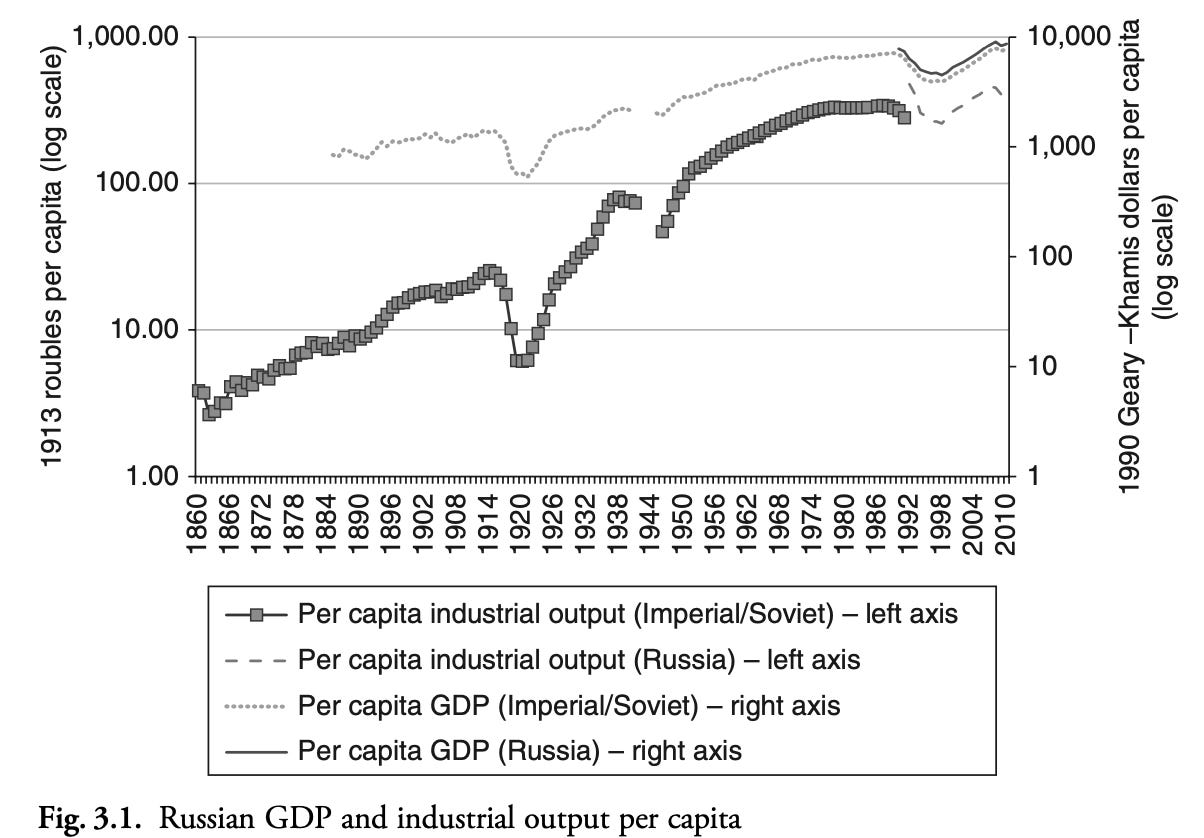
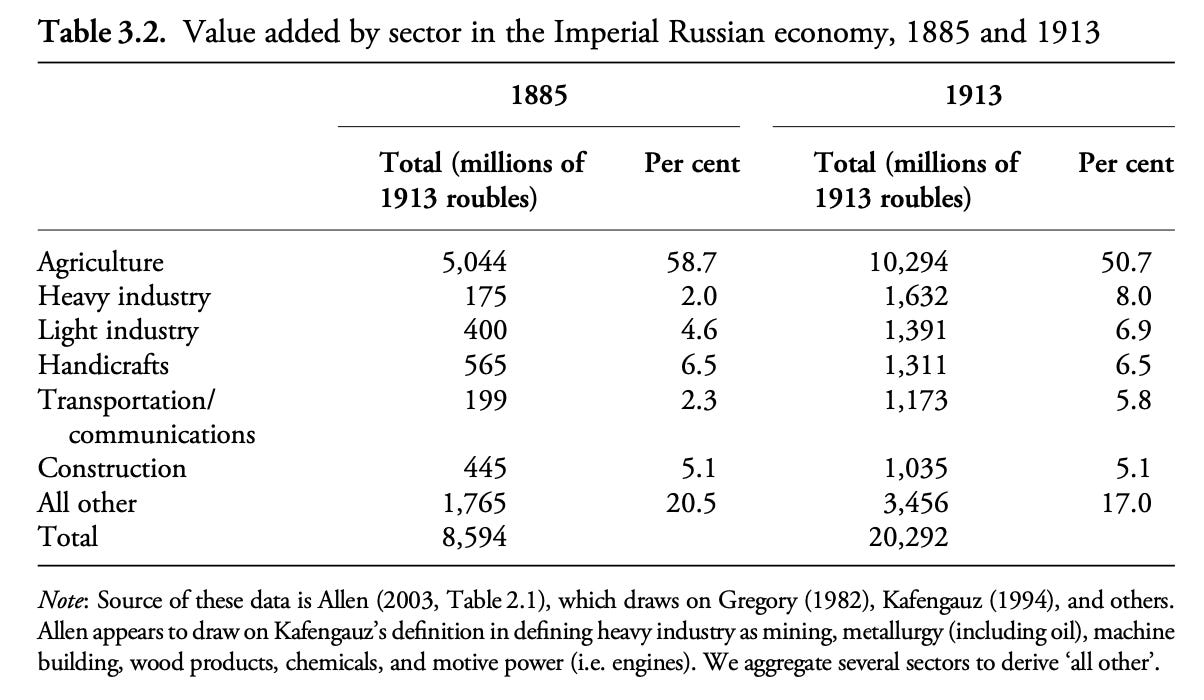
Moreover, if essentially any* major country continued to grow at pre-1913 rates it would have failed to reach a hypothetical 1989 income target. I've crudely and quickly drawn "Belle Epoque trend" growth paths onto the US, Germany, Britain, and France GDP trajectories for 1801-1993. Shockingly, everyone ends up a lot poorer. Growth wasn't very fast almost anywhere prior to 1939. And after 1945, a lot of places once deemed too "backward" for modernization got a healthy dose of it, with or without Communist mobilization.
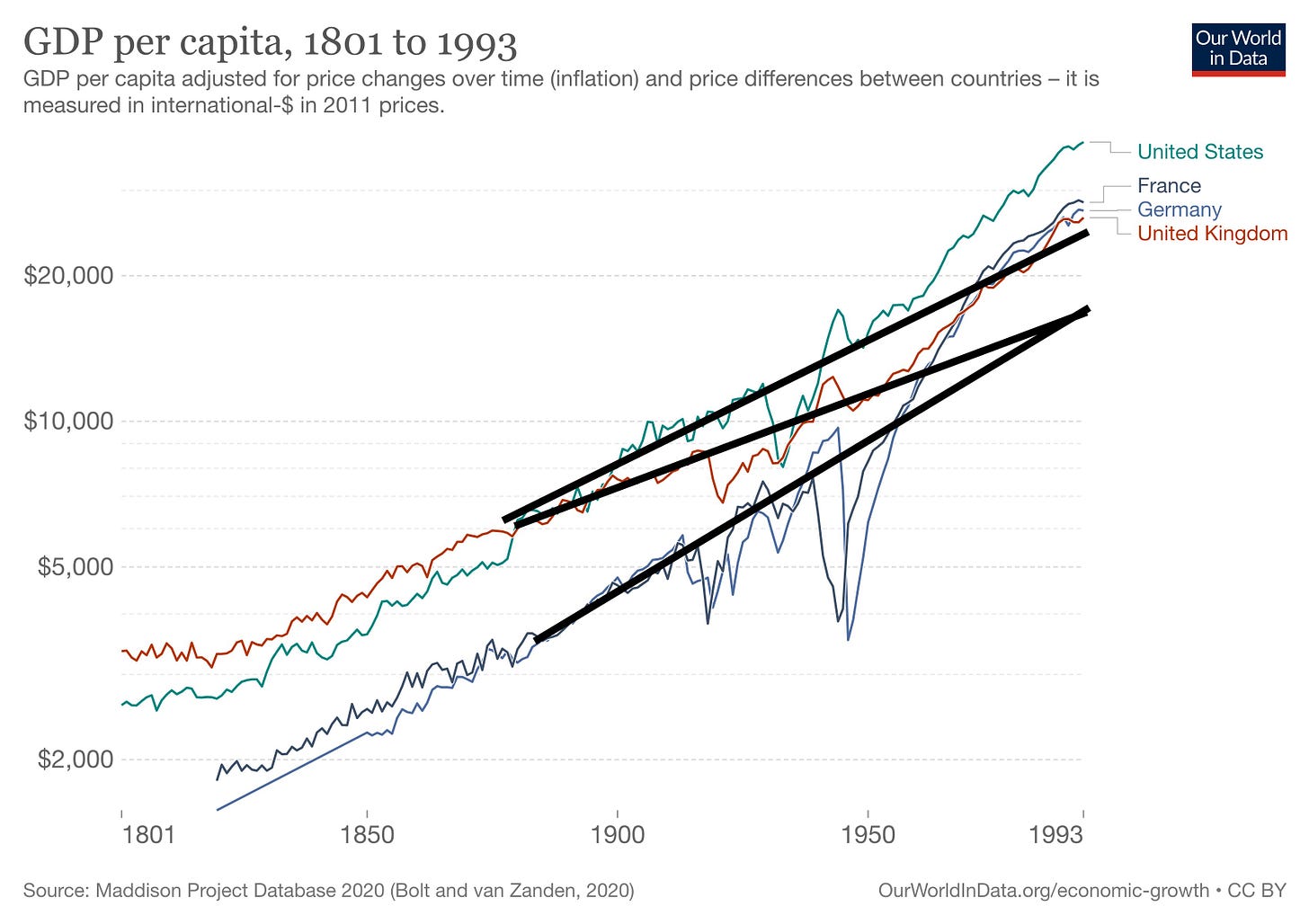
A major plank of Allen's model of Soviet industrialization is the program of forced saving imposed on farmers, under which agricultural products were purchased as prices that guaranteed a substantial profit for the regime. This was necessary to boost the investment rate and spur capital accumulation. Yet Russia's pre-war investment rate was high by contemporary standards and augmented by inflows of foreign capital.
Cheremukin et al. (2013, 2017) analyze the development of the Tsarist and Soviet economies over the long term. They "map" specific policies to "wedges" in a neoclassical growth model—distortions dividing the actual trajectory from an efficient economy. The most important was the concentrated, cartelized manufacturing sector, which was able to impose significant markups on product prices. The authors find that most of the Soviet economy's performance was driven by the reduction of these wedges: "high production targets set by the Soviet government during industrialization helped remove frictions caused by entry barriers and the monopolies."
However, the wedge reduction also slashed the USSR's TFP compared to the Tsarist trend. Low productivity, especially in agriculture, created offsetting welfare losses that resulted in worse short-run performance than the Tsarist counterfactual and possibly "moderate" long-run gains. But even in this case, the non-communist economy might, as Gregory argued, have higher welfare, if slightly less growth.
The baseline exercise, however, assumes no instutitional reforms. As we've discussed above, statis was unlikely. The government was (slowly) making reform efforts during the pre-war years, from the abolition of serfdom to the Witte and Stolypin programs. If this process had continued, as in Japan, the authors (in an earlier working paper) show that Russian growth would have far exceeded actual Soviet performance and led to large welfare gains.
Their conclusion is pretty devastating:
Therefore our answer to the ‘Was Stalin Necessary?’ question is a definite ‘no’. Even though we do not consider the human tragedy of famine, repression and terror, and focus on economic outcomes alone, and even when we make assumptions that are biased in Stalin’s favour, his economic policies underperform the counterfactual.
Furthermore, Nintil (thanks Anton) suggests that Allen exaggerates the superior performance of the Soviet economy by only considering data up to 1970. This is a bit like slapping Bush and Greenspan on the back for their great economic management between 2001 and 2008. If only the housing bubble hadn't blown up! When the 1970-1989 period is factored in, Soviet growth relative to starting GDP looks much worse. Indeed, the graph below shows that the worst-case Tsarist trend—no reforms, including 1914–leads to similar outcomes by 1989.
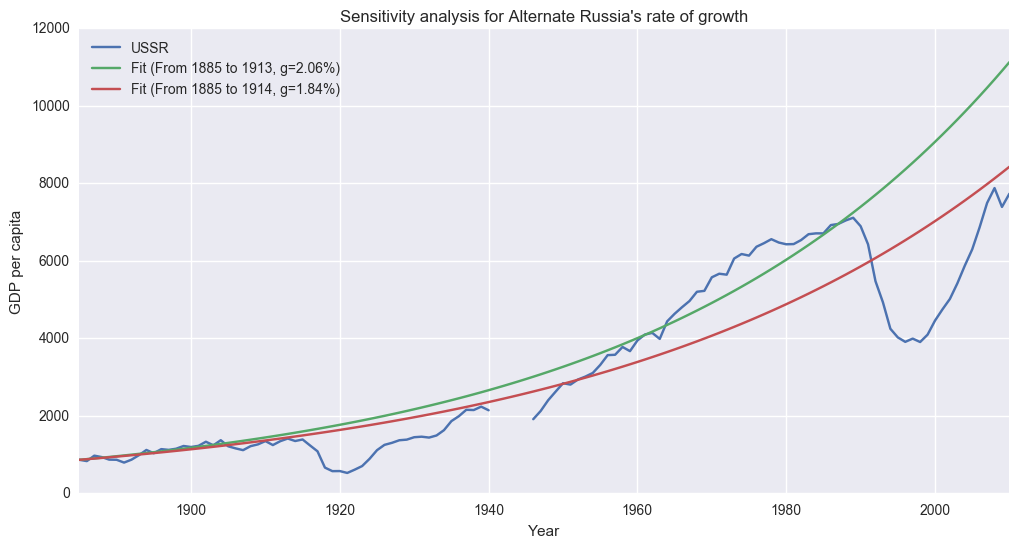
To summarize: the Tsarist economy was, despite inefficiencies, starting to grow during the last decades before the war. Growth was retarded by barriers to entry in the manufacturing sector and the simple fact that the early years of industrialization can be frustratingly slow, as in eighteenth-century Britain. Increasing industrial competition could have resulted in improved welfare and more structural change in Russia compared to the actual performance of the Soviet economy. Positive institutional developments prior to the war suggest that this was possible.
Industrialization
But was Soviet growth all attributable to the wheat boom, as Allen argues? No. Allen's suggestion that agriculture did all the heavy lifting is a fallacy of growth accounting. Dynamic but inchoate sectors always contribute slightly to aggregate output at first—until they collectively become large enough to contribute a lot. Unlike during the early phases of Britain's development in the eighteenth century, Russian industry was growing *much* faster than agriculture—and agriculture was hardly limping along. To say that agriculture contributed most to value-added is irrelevant because agriculture was the largest sector—if agriculture had grown by 35 percent instead of 104 percent, it still would have made a larger contribution than heavy and light industry *combined*.
The point is that the latter two sectors were growing relatively much faster. Indeed, Russian industry was growing much faster over 1870-1914 than that of any other European country—at 5.1 percent per annum, versus 4.1 percent in Germany and just 2.1 percent in France and England. Industrial capital per worker rose by 55 percent between the 1880s and 1913, and the overall growth rate (8-9 percent) of the capital stock was greater than that in other industrializers of the period.
Why shouldn't industry have located in Russia? The country was well-endowed with cheap unskilled labor and boundless stocks of cheap energy, including charcoal, coal, and oil. Industrial technology was available from abroad, though import tariffs did make it costlier than necessary. Russian interest rates were slightly higher than Western European during the Belle Epoque, on par with those of land-rich Argentina and Brazil; state investment guarantees attracted enormous foreign investment from France, Germany, and Britain. By the time that war broke out, Russia's foreign debt was the world's largest. Investors were pretty sure that the Tsarist regime was a good bet, insured by budgetary orthodoxy and the gold standard. Even so, Russia's foreign investment as a share of NNP was just -1.4 percent, which is similar to the US over 1869-88 (-1.0) and far less than Canada or Australia (-7.9 and -5.1 respectively).
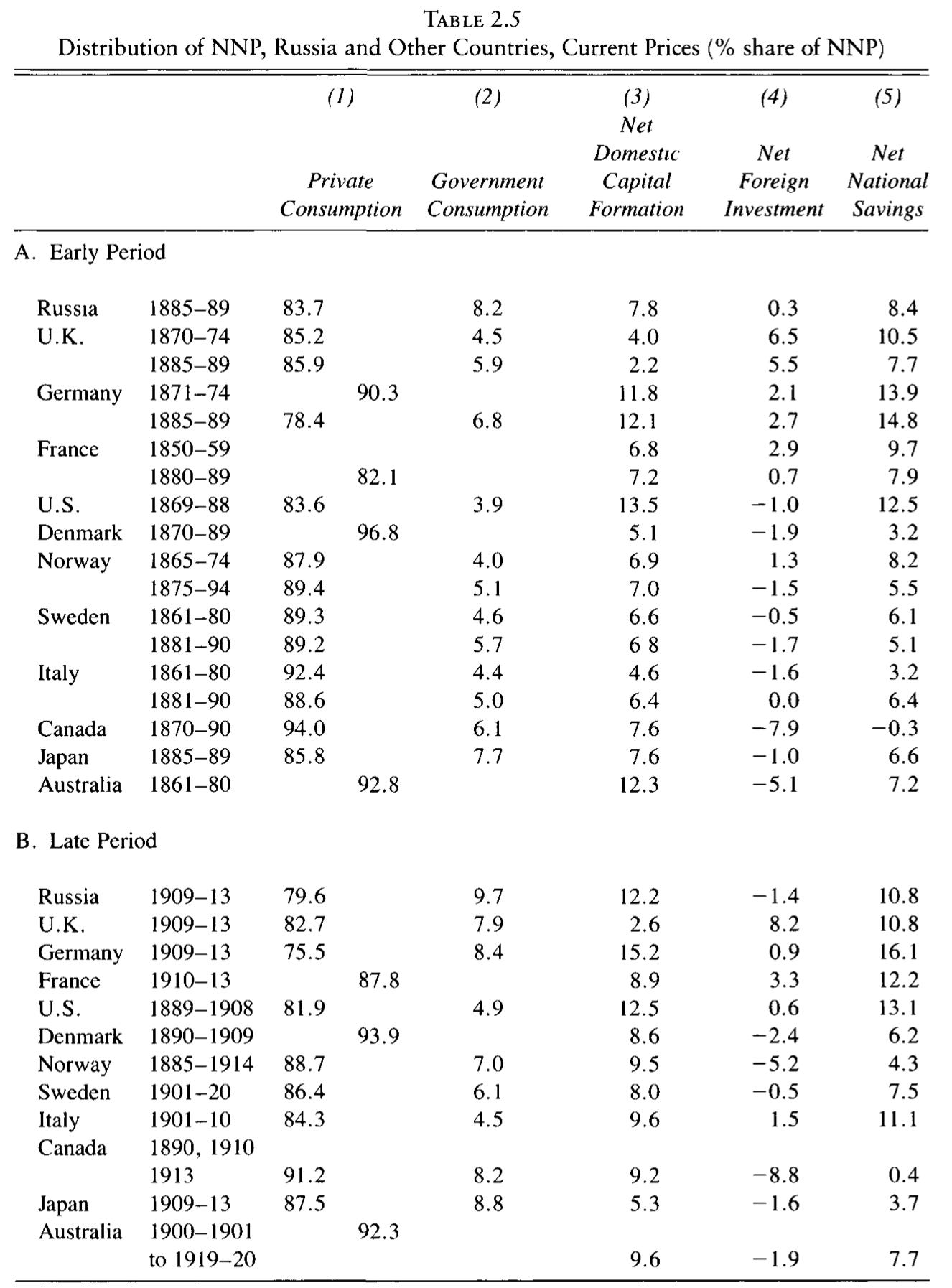
Would declining terms of trade have ruined the Russian farmer and stifled agricultural demand for urban goods? It's hard to say, and Allen's assertion remains fairly speculative. Peasant incomes had been rising steadily over 1885-1913, and Dennison and Nafziger (2012) show that rural households in the Rostov and Iur'ev districts had expanding consumer cultures characterized by newspaper product advertisements and sizeable budget shares devoted to non-food goods. Gregory (1980) found that rural consumers constituted a sizeable market for domestic industry already prior to 1890. Was this all contingent on the wheat boom? Or could the rise of Russian industry have picked up the slack? Other nations survived—and the ones that didn't, like Argentina, had much smaller domestic markets than did Russia.
Allen's argument that Tsarist Russia was doomed by protectionism, primary product exports, and the end of the railroad boom looks worst in comparative perspective. Canada, Australia, and yes, the United States all built thousands of miles of track and used them to ship out crops (including wheat!). Allen's own (later) work on the United States argues that "American industrialization in the nineteenth century required tariff protection since the country's comparative advantage lay in agriculture" (sound familiar?).
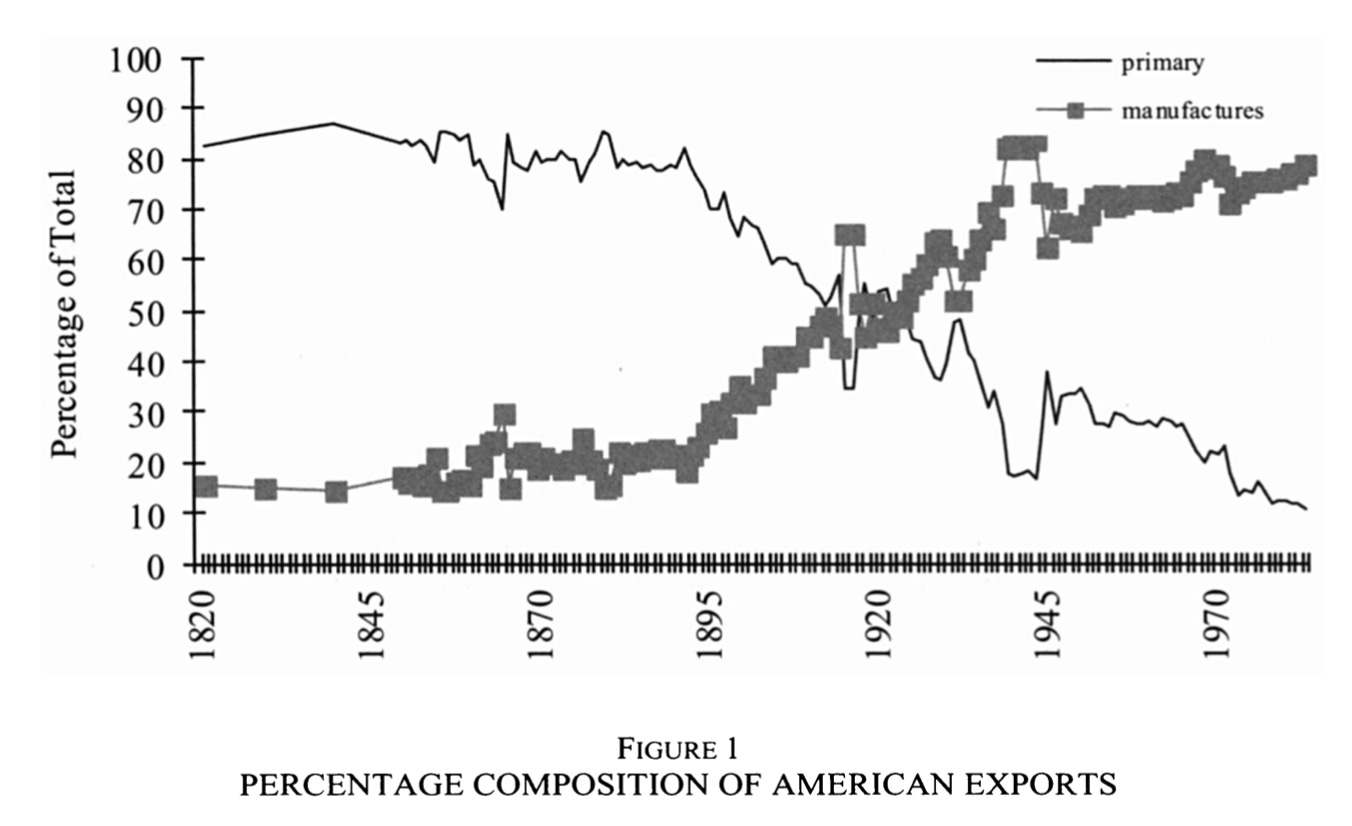
This pretty striking graph shows that primary products represented over 80 percent of US exports until the 1890s and were still over 50 percent at the end of World War I. Did the prevalence of cotton in US exports doom it to a Latin American fate? Meanwhile, Canada was Russia's mirror image in the Belle Epoque—a giant wheat exporter linked by railroads to the international market that took up protectionism through the "National Policy" after the late 1870s. Not bad company! As Gregory writes in his review of Farm to Factory, "Allen emphasizes the deleterious impact of the Great Depression on a non-communist Russia's agriculture, but contemporary living standards of affluent economies with competitive agricultures (Australia, New Zealand, Canada, and to some degree the United States) are today unaffected by the remote events of the late 1920s and early 1930s."
Even if you don't buy comparisons with the British offshoots, say for institutional or trade-relationship reasons, it's hard to deny that Finland, Denmark, and Sweden—all agrarian regions (and much smaller!) relatively close to Russia and similarly backward—turned out okay! So I am pretty skeptical that primary product orientation spelled Russia's doom.
The Agrarian Problem
Was there an "agrarian crisis" in the late prewar years? Gerschenkron argued that the retention of the commune (instead of distributing land to individuals) after the emancipation of 1861 made Western European agriculture impossible. The Emancipation Act of 1861 forced peasants to pay off their mortgages before removing land from the commune but failed to create a capital market that would let them do this. Thus no agglomeration of holdings took place, investment was disincentivized, and land could not be reallocated to its most productive uses. The Stolypin reform of 1905-6, which canceled peasant debts and allowed farmers to remove land from the commune, came too late, in Gerschrenkron's account, to alleviate rural poverty.
Under the 1906 Stolypin reform, peasants were able to convert their land from communal to hereditary tenure and consolidate their scattered strips from around the village into enclosed, contiguous plots. Updates in 1910 and 1911 lowered the costs of exit, allowed households that had not experienced repartition in the last 50 years to gain property title, permitted households to consolidate without leaving the commune, and made consolidation itself obligatory if 20 percent of the commune's households wished it. The number of peasants in the communes fell by 2.5 million from 1905 to 1915 and the percent of land held by the institutions from 83 to 71 percent, before the outbreak of war halted changes.
The process of exit was complicated, and perhaps 250,000 were pressured to give up the application by their communes. But the reforms appear to have been successful. Larger farms were more cost-effective by saving on labor, livestock, and farm tools and had access to cheaper credit. Consolidation led, per a 1913 survey, to increased use of agricultural machines, hired labor, and the replacement of the three-field with the many-field system. Castañeda Dower and Markevich (2019) found a large positive effect of the Stolypin reforms, primarily through land consolidation—the net effect was a doubling of land productivity.
And this was in an already-improving agricultural context. Gregory (1994) finds that Russian agriculture was rising growing per capita output and living standards. Peasants were consuming greater portions of their wheat harvests and probably experienced real wage growth (as opposed to marketing them and eating cheaper crops). Though legally the commune "could not have been set up in a worse form for raising productivity," Gregory argues that it could have been a "flexible" institution in which land could be redistributed through informal agreement. This is speculative, but at least the underlying data doesn't support a view of peasant immiseration. I am agnostic on Allen's take, which is that rising productivity was capitalized into increased land values, which only benefited owners and led to an equilibrium of holding parcellization.
Borodkin et al. (2008) offer evidence against the claim that farm labor was "trapped" in the countryside, showing that the rural-urban wage gap was stable at around 35 percent. Indeed, over 1884-1910 there were signs of convergence between urban and rural labor markets, especially in industrializing St. Petersburg. Demand shocks provoked similar responses in the city/country wage series. Thus peasant labor A) wasn't completely immobilized by the commune system and B) was available for employment in urban industry even without Stalinism. This finding is confirmed by Cheremukin et al., whose neoclassical modeling exercise attributes very little of the Tsarist economy's inefficiencies to agricultural labor mobility.
It is also untrue that aggregate economic gains were frittered away by extreme inequality. Lindert and Nafziger (2014) recently calculated inequality across Russia for 1904 and found that it was unexceptional by the standards of the period. Lenin's thesis about the differentiation of the peasantry, which was to have such tragic consequences under Stalin, remains unproven.
In sum, there is little evidence to suggest that Russian agrarian systems were blocking industrialization. Labor could move into urban industry, and rising living standards made peasant families consumers of manufactured goods, providing a market for factories operating within the country's tariff walls. The Stolypin reforms were incomplete at the time of the Revolution, but they probably helped to increase living standards, if at the possible cost of additional social conflict.
Conclusions
I'm not arguing that Russia was Japan. The Tsarist regime and its supporting elite were less pro-developmental than the Japanese, and levels of human capital were low, if slowly improving. Russia's geographical endowments and social structure made rapid Japanese-style industrialization unlikely. But judging Russia against the most successful rapid industrializer in history doesn't seem to be very credible. Instead, Tsarist Russia was in the early stages of a not-too-atypical European development pattern, hamstrung by poor (but not fatal) political economy and rapid population growth. I concur with Peter Gregory (1994) in that "[t]he structural changes that occurred in the thirty years preceding World War I were in line with the first thirty years of modern economic growth elsewhere" and that "Russia definitely had begun the process of modern economic growth by the outbreak of the First World War I."
As Gregory concedes, Russian growth certainly "began under unfavorable circumstances." These included the weakness of property rights (especially in agriculture), anti-competitive tariff barriers, and a corrupt and regressive bureaucracy headed by a cautious autocrat. But growth began nonetheless, and it seems probable that, had the stable international system of the Belle Epoque endured, Russia could have continued its structural transformation amid gradual political thawing. Per capita growth probably would have been accelerated post-1913, if only because population growth would eventually have slowed as the demographic transition took hold, and growth increased with rising literacy and science/technology imports. And that’s assuming no further institutional shifts toward inclusion and developmentalism—which in light of the regime’s international and domestic concerns seems unlikely. How much faster is tough to say, and while I wouldn't bet on Japanese rates, I don’t think convergence with parts of Western Europe was out of the question.
I'm also not arguing that counterfactual Tsarist growth would have been *faster* than under Lenin and Stalin—I just don't know. I find Allen's story of rapid labor mobilization, increased human capital, and an accelerated demographic transition relatively convincing (or at least intimidating) from a conceptual point of view. For this essay, it's sufficient to argue that growth could have occurred under the Romanovs, especially if instutions continued to get better. Protectionism and industrial policy could have succeeded in growing up competitive industries, especially given Russia's large internal market, low wages, and cheap energy.
Instead of viewing the Revolution of 1917 as an inevitable outcome of limited development, we should accept the more obvious answer: that the destruction of the Russian economy during the First World War—GDP per capita fell by 20 percent—combined with an already-fragile political and economic situation to induce mass unrest. Without the war, it's possible that Russian growth and (potentially) institutional change would have delivered the goods and forestalled the violent destruction of the old order.
